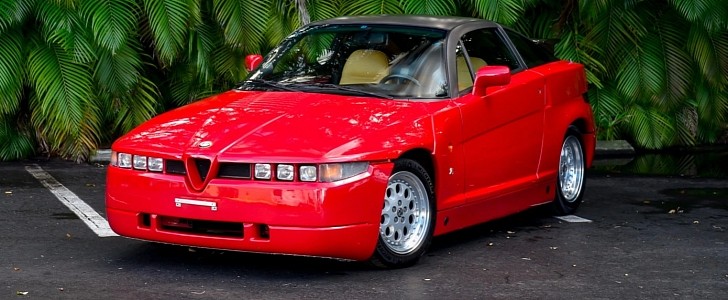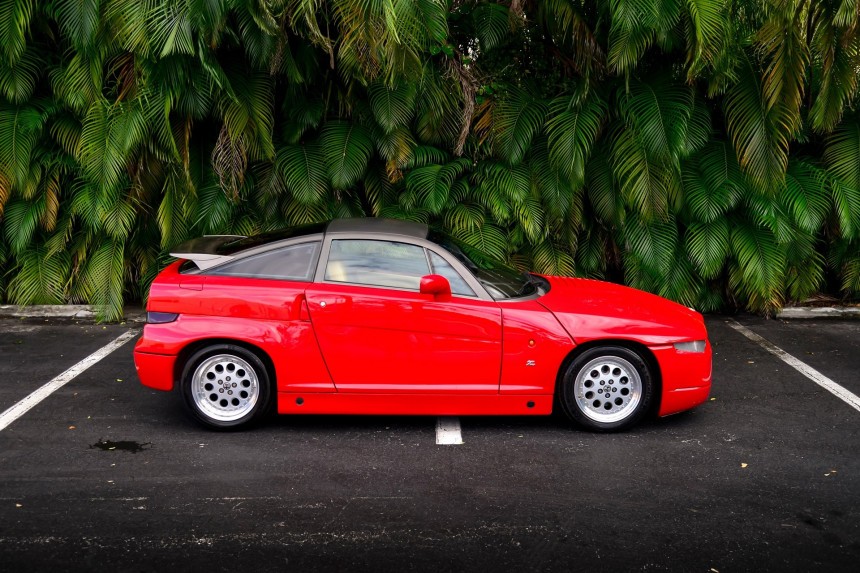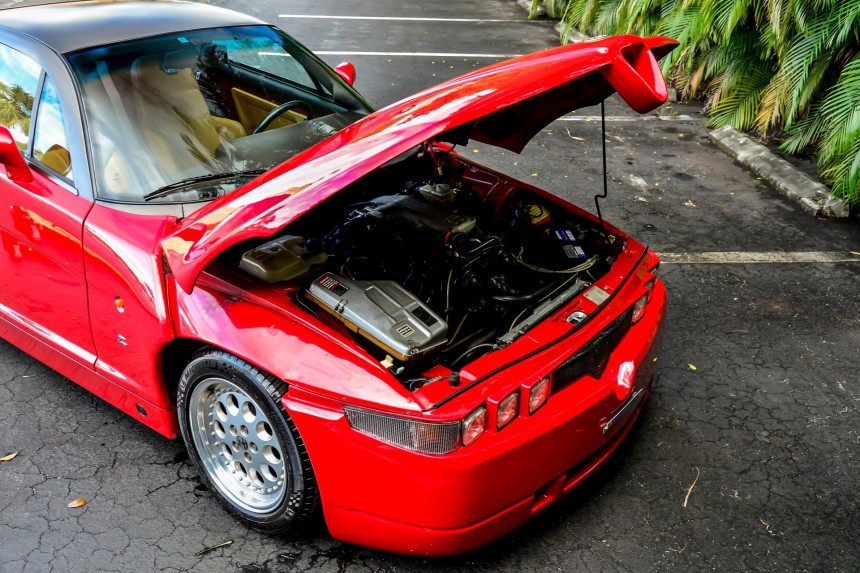Alfa Romeo wasn’t financially sound in the 1980s. Following the golden era that brought us the likes of the Giulia Sprint, Spider Duetto, and Montreal, the Milanese automaker was acquired by the Fiat Group in 1986. This fateful takeover paved the way to almost three decades of mediocre cars until the 4C and Giorgio-based Giulia, yet under the Turinese yoke, Alfa Romeo worked miracles on a limited budget.
Codenamed ES-30 for Experimental Sports car 3.0 liters, the SZ project took 19 months from design study to finished product. Alfa Romeo presented the car with extremely familiar componentry at the 1989 Geneva Motor Show.
The chassis, a steel monocoque dressed in thermoplastic body panels produced by Carplast and Stratime, came from the 75 sedan that was alternately marketed as the Milano in America. Don’t, however, think for a single moment that’s all there is to the underpinnings of this polarizing machine. Alfa Corse developed quite a few parts for the 75 Turbo Evoluzione, and some of those parts were gingerly used in the Sprint Zagato.
Bodied in a thermosetting methacrylic resin composition reinforced with fiberglass, the flagship coupe employs double-wishbone suspension up front and a de Dion setup with a Watts linkage and converging rods. Anti-roll bars are featured fore and aft to reduce body roll during fast cornering.
The go-faster theme continues with hydraulically-adjustable dampers that improve ride height by 50 millimeters (almost 2.0 inches) at the press of a button on the center console. Stopping power comes courtesy of ventilated rotors that measure 284 millimeters up front and 250 millimeters out back.
Originally fitted with 16-inch alloys from OZ that measure seven inches and eight inches in width, the SZ was penned by Robert Opron and Antonio Castellana. Zagato finalized the design, which can be described as original. It’s not beautiful nor ugly, but a love-it-or-hate-it affair that captures one’s attention by the scruff of the neck better than a period Ferrari or Lambo.
Finished exclusively in Rosso Alfa 130 with Grigio Scuro 633 for the roof, the Sprint Zagato is more aerodynamic than it appears. Alfa Romeo says that we’re dealing with a drag coefficient of 0.30 Cd. The Pagani Huayra, by comparison, is rated at 0.31 to 0.37 Cd thanks to active aero trickery.
Tipping the scales at 1,260 kilograms (2,778 pounds), the SZ isn’t particularly quick. Zero to 100 kilometers per hour (62 miles per hour) is dealt with in seven-odd seconds, and top speed is estimated at 245 kilometers per hour (152 miles per hour), according to the Italian manufacturer.
Universally praised for the way it handles, the Sprint Zagato sounds particularly nice. The Busso engine, a naturally-aspirated V6 with the cylinder banks angled at 60 degrees and a displacement of 3.0 liters, is rocking two valves per cylinder and two single overhead camshaft heads.
Equipped with three-way catalytic converters and Bosch Motronic ML 4.1 multi-point electronic fuel injection, the free-breathing lump cranks out 210 ps (207 horsepower) at 6,200 revolutions per minute and 245 Nm (181 pound-feet) of torque at 4,500 revolutions per minute. A six-speed manual transaxle is tasked with channeling those resources to the rear end.
Standard features include air conditioning, electric mirrors, electric windows, beige leather, and that’s about it. Alfa Romeo couldn’t be bothered with a conventional trunk, but a trunk that fits the spare tire and a toolbox. The luggage area is limited to the shelf behind the bolstered seats.
Produced by Zagato in Terrazzano di Rho, the Sprint Zagato was discontinued in 1991 with 1,036 examples to its name. Offered between 1992 and 1994, the RZ was phased out after 278 units. The RZ weighs more and is a little bit slower, but unlike the SZ, the canvas-topped roadster could be had in three colors: Rosso Alfa, Nero, and Giallo Ginestra. Three RZs were painted Argento, and the final RZ was finished in a very look-at-me pearlescent white.
Lovingly nicknamed Il Mostro, the SZ shares only the front fenders with its open-top sibling. Equally divisive and provocative, this duo influenced subsequent Alfa Romeos. The GTV and Spider spring to mind with a distinct wedge shape when other brands were going for the soft stuff. The six-unit lights, on the other hand, were reimagined for the 159 and Brera.
The chassis, a steel monocoque dressed in thermoplastic body panels produced by Carplast and Stratime, came from the 75 sedan that was alternately marketed as the Milano in America. Don’t, however, think for a single moment that’s all there is to the underpinnings of this polarizing machine. Alfa Corse developed quite a few parts for the 75 Turbo Evoluzione, and some of those parts were gingerly used in the Sprint Zagato.
Bodied in a thermosetting methacrylic resin composition reinforced with fiberglass, the flagship coupe employs double-wishbone suspension up front and a de Dion setup with a Watts linkage and converging rods. Anti-roll bars are featured fore and aft to reduce body roll during fast cornering.
The go-faster theme continues with hydraulically-adjustable dampers that improve ride height by 50 millimeters (almost 2.0 inches) at the press of a button on the center console. Stopping power comes courtesy of ventilated rotors that measure 284 millimeters up front and 250 millimeters out back.
Finished exclusively in Rosso Alfa 130 with Grigio Scuro 633 for the roof, the Sprint Zagato is more aerodynamic than it appears. Alfa Romeo says that we’re dealing with a drag coefficient of 0.30 Cd. The Pagani Huayra, by comparison, is rated at 0.31 to 0.37 Cd thanks to active aero trickery.
Tipping the scales at 1,260 kilograms (2,778 pounds), the SZ isn’t particularly quick. Zero to 100 kilometers per hour (62 miles per hour) is dealt with in seven-odd seconds, and top speed is estimated at 245 kilometers per hour (152 miles per hour), according to the Italian manufacturer.
Universally praised for the way it handles, the Sprint Zagato sounds particularly nice. The Busso engine, a naturally-aspirated V6 with the cylinder banks angled at 60 degrees and a displacement of 3.0 liters, is rocking two valves per cylinder and two single overhead camshaft heads.
Standard features include air conditioning, electric mirrors, electric windows, beige leather, and that’s about it. Alfa Romeo couldn’t be bothered with a conventional trunk, but a trunk that fits the spare tire and a toolbox. The luggage area is limited to the shelf behind the bolstered seats.
Produced by Zagato in Terrazzano di Rho, the Sprint Zagato was discontinued in 1991 with 1,036 examples to its name. Offered between 1992 and 1994, the RZ was phased out after 278 units. The RZ weighs more and is a little bit slower, but unlike the SZ, the canvas-topped roadster could be had in three colors: Rosso Alfa, Nero, and Giallo Ginestra. Three RZs were painted Argento, and the final RZ was finished in a very look-at-me pearlescent white.
Lovingly nicknamed Il Mostro, the SZ shares only the front fenders with its open-top sibling. Equally divisive and provocative, this duo influenced subsequent Alfa Romeos. The GTV and Spider spring to mind with a distinct wedge shape when other brands were going for the soft stuff. The six-unit lights, on the other hand, were reimagined for the 159 and Brera.









































